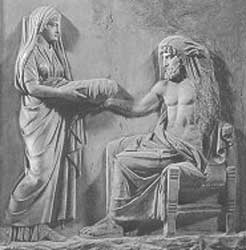.

Rhea gives to Cronus a rock wrapped in clothes.
Rhea (she who flows) was the Titaness daughter of Uranus and of Gaia. She was both sister and wife to Cronus and mother to Demeter, Hades, Hera, Hestia, Poseidon, and Zeus. She was strongly associated with Cybele. In Roman mythology, she was Magna Mater deorum Idaea and identified with Ops.
In art, Rhea was usually depicted on a chariot drawn by two lions, not always distinguishable from Cybele.
Her husband, Cronus, castrated their father, Uranus. After this, Cronus re-imprisoned the Hecatonchires, the Gigantes and the Cyclopes and set the monster Campe to guard them. He and Rhea took the throne as King and Queen of the gods. This time was called the Golden Age as the people of the time had no need for laws or rules; everyone did right and as such, there was no need.
Cronus sired several children by Rhea: Hestia, Demeter, Hera, Hades, Poseidon, but swallowed them all as soon as they were born, since he had learned from Gaia and Uranus that he was destined to be overcome by his own son as he had overthrown his own father. But when Zeus was about to be born, Rhea sought Uranus and Earth to devise a plan to save him, so that Cronus would get his retribution for his acts against Uranus and his own children. Rhea gave birth to Zeus in Crete, handing Cronus a stone wrapped in swaddling clothes which he promptly swallowed.
Rhea tricking Cronus with a wrapped stone.
Then she hid Zeus in a cave on Mount Ida in Crete. According to varying versions of the story:
He was then raised by Gaia.
He was suckled by a goat named Amalthea, while a company of Kouretes, soldiers, or smaller gods danced, shouted and clapped their hands to make noise so that Cronus would not hear the baby's cry.
He was raised by a nymph named Adamanthea. Since Cronus ruled over the earth, the heavens and the sea, she hid him by dangling him on a rope from a tree so he was suspended between earth, sea and sky and thus, invisible to his father.
In Greek mythology, the Titan Zeus forced Cronus to disgorge the other children in reverse order of swallowing: first the stone, which was set down at Pytho under the glens of Parnassus to be a sign to mortal men, then the rest. In some versions, Metis gave Cronus an emetic to force him to disgorge the babies, or Zeus cut Cronus' stomach open. Then Zeus released the brothers of Cronus, the Gigantes, the Hecatonchires and the Cyclopes, who gave him thunder and the thunderbolt and lightning, which had previously been hidden by Gaia. Together, Zeus and his brothers and sisters with the Gigantes, Hecatonchires and Cyclopes overthrew Cronus and the other Titans.
In Homer Rhea is the mother of the gods, though not a universal mother like Cybele, the Phrygian Great Mother, with whom she was later identified. The original seat of her worship was in Crete. There, according to legend, she saved the new-born Zeus, her sixth child, from being devoured by Kronos, by substituting a stone for the infant god and entrusting him to the care of her attendants the Curetes. These attendants afterwards became the bodyguard of Zeus and the priests of Rhea, and performed ceremonies in her honour. In historic times the resemblances between Rhea and the Asiatic Great Mother, Phrygian Cybele, were so noticeable that the Greeks accounted for them by regarding the latter as only their own Rhea, who had deserted her original home in Crete and fled to the mountain wilds of Asia Minor to escape the persecution of Kronos (Strabo. 469, 12). The reverse view was also held (Virgil, Aeneid iii), and it is probably true that cultural contacts with the mainland brought to Crete the worship of the Asiatic Great Mother, who became the Cretan Rhea.
In Greek mythology, Rhea's symbol is the moon. However, in Roman mythology, her symbol is known as the lunar (which would seem to mean "Moon"). She has another symbol, the swan, because it is a gentle animal. Also, her other symbol is two lions, supposedly the ones that pull her chariot.
See also : Greek Mythology. Paintings, Drawings
Greek Mythology Index
A - B - C - D - E - F - G - H - I - J - K - L - M -
N - O - P - Q - R - S - T - U - V - W - X - Y - Z
Α - Β - Γ - Δ - Ε - Ζ - Η - Θ - Ι - Κ - Λ - Μ -
Ν - Ξ - Ο - Π - Ρ - Σ - Τ - Υ - Φ - Χ - Ψ - Ω
| Ancient Greece
Science, Technology , Medicine , Warfare, , Biographies , Life , Cities/Places/Maps , Arts , Literature , Philosophy ,Olympics, Mythology , History , Images Medieval Greece / Byzantine Empire Science, Technology, Arts, , Warfare , Literature, Biographies, Icons, History Modern Greece Cities, Islands, Regions, Fauna/Flora ,Biographies , History , Warfare, Science/Technology, Literature, Music , Arts , Film/Actors , Sport , Fashion --- |
Retrieved from "http://en.wikipedia.org"
All text is available under the terms of the GNU Free Documentation License

